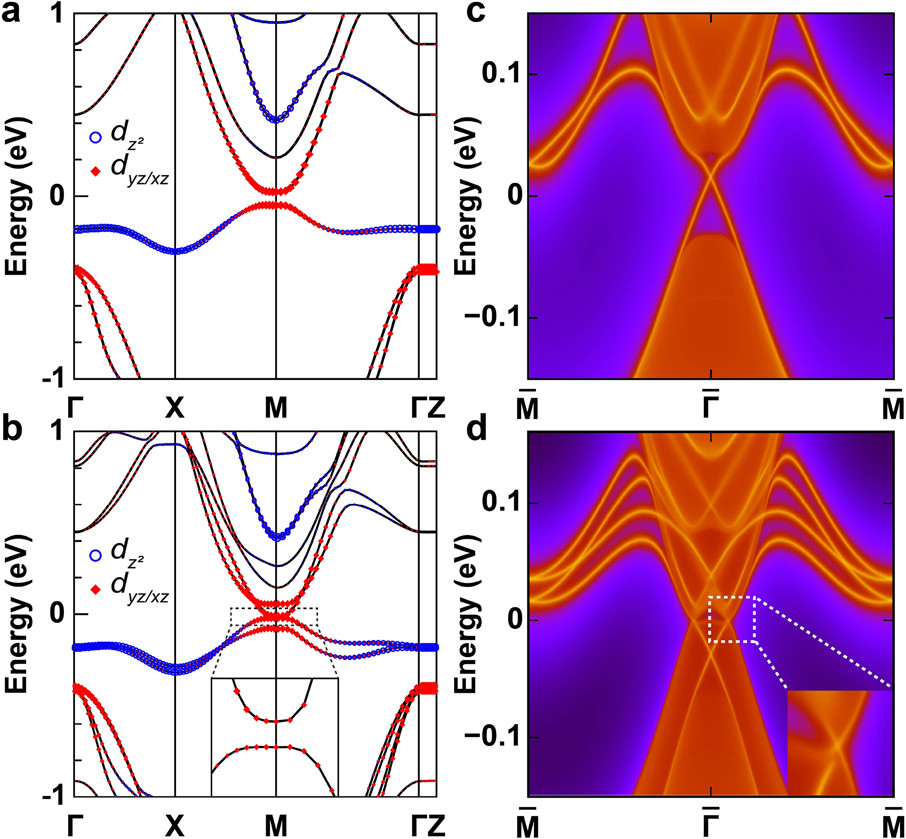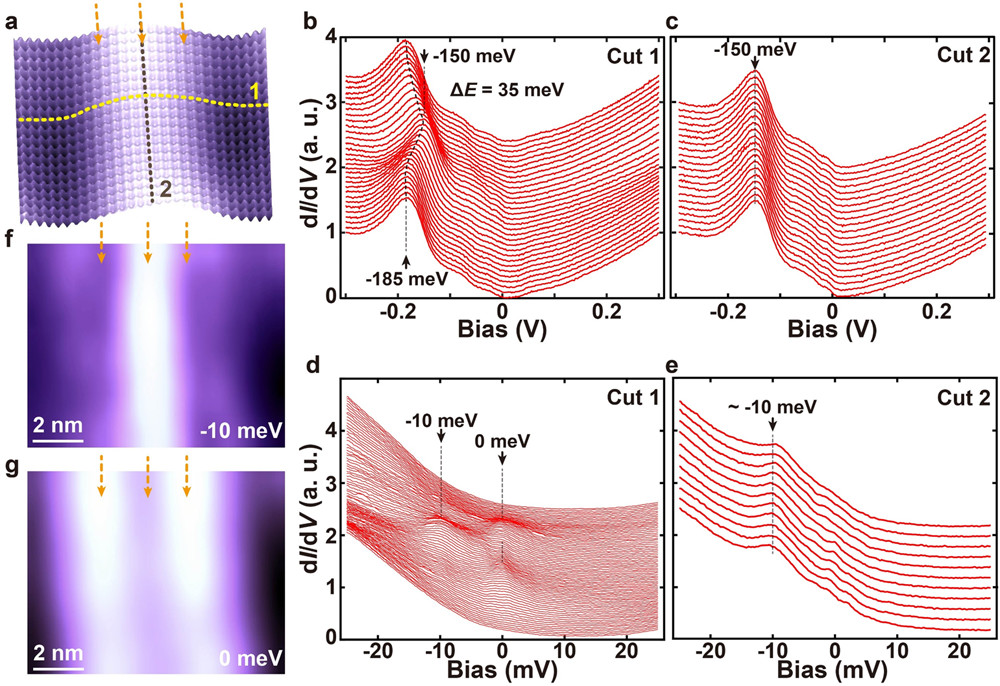
Band structure and topological edge states.a, bband structures for monolayer and bilayer FeSe respectively.c, dcalculated topological edge states for monolayer and bilayer FeSe along(110)orientation, respectively.

Edge state and electronic structure at domain boundaries.athree dimensional STM of domain boundaries;b, cspatially resolved dI/dV spectra along the dotted line (cut1 and cut2) ina(V=-300 mV,It= 0.2 nA);d, etwo clear peaks at 0 meV and -10 meV along the dotted line ina(V=-25 mV,It= 0.3 nA);f, gspatially resolved density of states ofaat -10 meV and 0 meV, respectively.
(Nano letters, 2018, DOI: 10.1021/acs.nanolett.8b03282)
Background
Iron selenide (FeSe) is an intriguing material, which show many exotic states, such as high-Tcsuperconductivity, nematic ordering, possible magnetism and topological characters. At low temperature, Nematicity transition arise in FeSe spontaneously, coincident with 4-fold rotational symmetry-breaking of the tetragonal Fe-lattice. Nematicity suppression can occur at the boundaries of nematic domains (domain walls), due to the overlap of two orthogonal nematic domains. However, because of the complexity on both sides of sample preparation and precision measurement, the nematicity suppression on domain boundaries has not yet been studied.
What we discover?
In the work on Nano Letters 18, 7176,experimental scientists from Tsinghua Universityuse molecular beam epitaxy to prepare FeSe films with atomically sharp nematic domain boundaries, where tensile strains, nematicity suppression and topological band inversion are simultaneously achieved. Using scanning tunneling microscopy, topological edge states at the Fermi level that spatially distribute as two distinct strips in the vicinity of the domain boundaries are observed in both odd and even layers of FeSe films.
By means of the first-principles calculation and theoretical analysis, Gang Xu and Bin Liu from Wuhan National High Magnetic Field Center & School of Physics HUST, explain the topological origin of the characteristic peak of dI/dV spectrum in the experiment very well: on the domain wall, thetensile strains and nematicity suppression, combined with the Neelantiferromagnetic (AFM) ordering, will drive the system into a2D AFMZ2nontrivial quantum spin hall insulator (odd layers), or the AFM topological crystalline insulator (even layers). Robust edge state protected by spacial-time reversal symmetry can exist at the domain boundary of odd layers. While for the even layers, there will be an edge state of topological crystalline insulator protected by the slide mirror symmetry at the domain boundary.
Why is this important?
The realization of the topological edge states at domain boundaries in FeSe films, not only demonstrate a candidate for quantum spin Hall Effect, but also provide a new pathway to realize topological superconductivity in a single-component film.
Who did the research?
Yonghao Yuan†,Wei Li*†‡||,Bin Liu§,Peng Deng†,Zhilin Xu†,Xi Chen†‡,Canli Song†‡,Lili Wang†‡,Ke He†‡||,Gang Xu*§,Xucun Ma†‡, andQi-Kun Xue*†‡||
†State Key Laboratory of Low-Dimensional Quantum Physics, Department of Physics, Tsinghua University, Beijing100084, China
‡Collaborative Innovation Center of Quantum Matter, Beijing 100084, China
§Wuhan National High Magnetic Field Center & School of Physics, Huazhong University of Science and Technology, Wuhan 430074, China
||Beijing Academy of Quantum Information Sciences, Beijing 100193, China
Wei Li, Xue Qikun from Tsinghua University and Gang Xu from HUST are co-corresponding authors.
